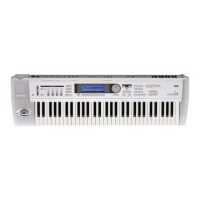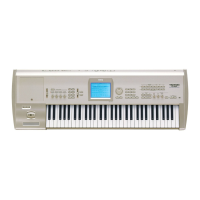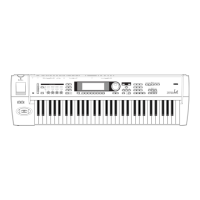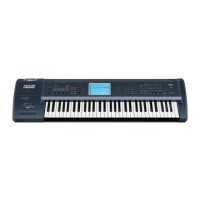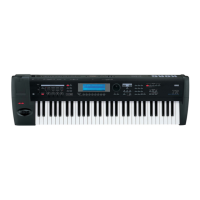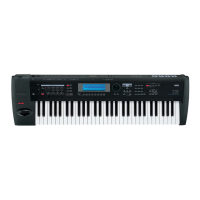5. Sequencer mode
42
About patterns
Each song in the TRINITY’s sequencer can have up to 100 of its own patterns.
Phrases that are used repeatedly in a song can be recorded as patterns. If these patterns are placed
in a track, the pattern data will be called up and played back whenever the song reaches that loca-
tion.
If a song contains repeated phrases or rhythms, you can save memory by recording the phrase or
rhythm as a pattern, rather than actually recording it in each location where you want it to play-
back.
When using patterns, you need to be aware that when you modify a pattern, the playback will be
affected for all locations that use that pattern. Pattern lengths can be in multiples of a measure.
Each pattern contains playback data for a single track. It is not possible to create patterns that are
played back by two or more tracks (multi-track patterns).
How song data is stored on a floppy disk
There are two types of song data that the TRINITY is able to load from disk and play back.
One is song data that has been saved in the TRINITY’s own format. This data cannot be loaded by
other devices, but since all details of the settings and playback will be reproduced with complete
accuracy, you should use this format to save data that will be played back on a TRINITY series
instrument.
The other type is Standard MIDI File data. With this type of data, the reproduction will not be
quite as accurate as with the TRINITY’s own format (although for most purposes there will be no
problem), but the data can be played back by any SMF-compatible device.
Song data is saved to and loaded from floppy disk in Disk mode. For details refer to “9. Saving
data” on page 56 of this manual.
How the TRINITY uses MIDI
The sequencer of the TRINITY can control and be controlled by external MIDI devices in the fol-
lowing ways.
MIDI Clock setting in Global mode
This setting determines whether the TRINITY will be the master (the controlling device) or the
slave (the controlled device).
When the TRINITY is connected to an external sequencer, and you want to perform start/stop
and tempo control from the TRINITY, set the MIDI Clock setting to Internal.
If you want to use the external sequencer to control the TRINITY, set the MIDI Clock setting to
External.
For details refer to Parameter Guide page 132 “1–1d: MIDI Clock/System Clock.”
Track Status of each track
You can specify whether data played back by the TRINITY’s sequencer or received via MIDI will
sound the TRINITY’s internal tone generator, or will sound an external tone generator.
To sound the internal tone generator, set the Track Status to INT.
To sound external tone generators, set the Track Status to EXT.
With a setting of BOTH, both the internal and external tone generators will sound.
For details refer to Parameter Guide page 90 “2–1c: Track Status.”
Keyboard and controller data transmission
When the keyboard and controllers of the TRINITY are operated, keyboard and controller data
will be transmitted on the MIDI channel specified for the current track (selected in Sequencer
mode “1–1d: Track”).
